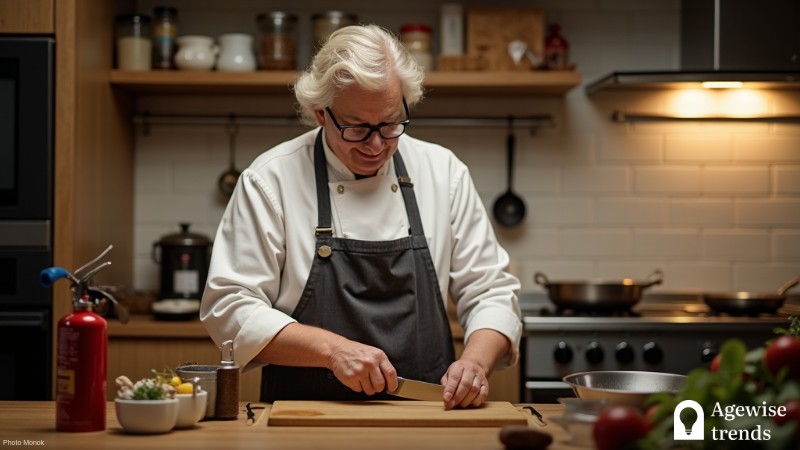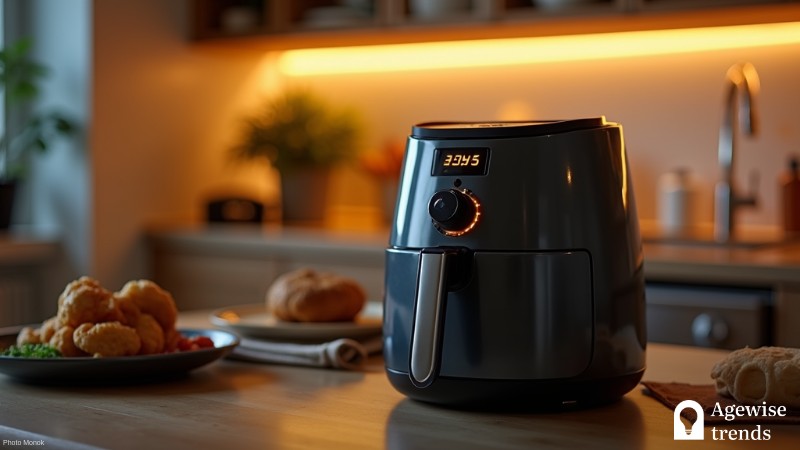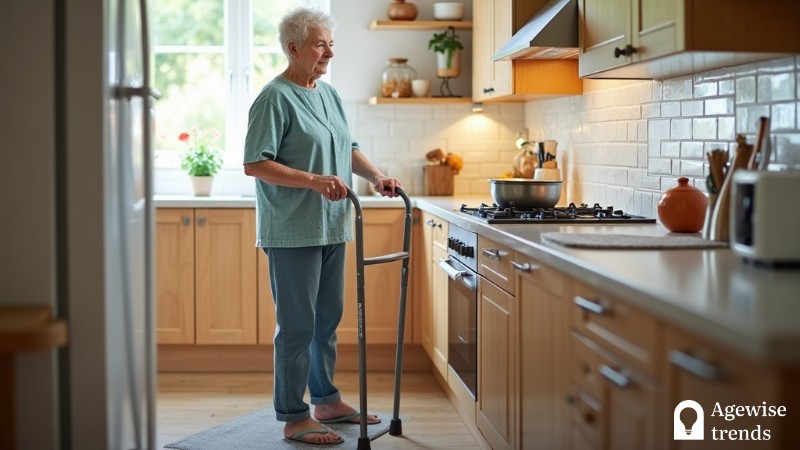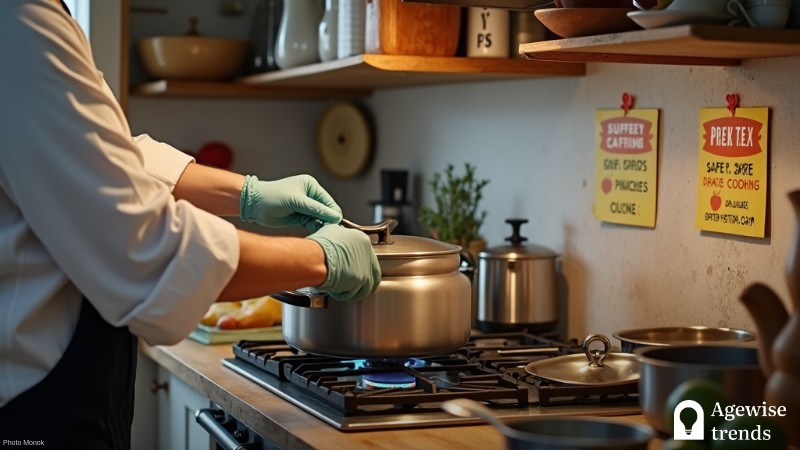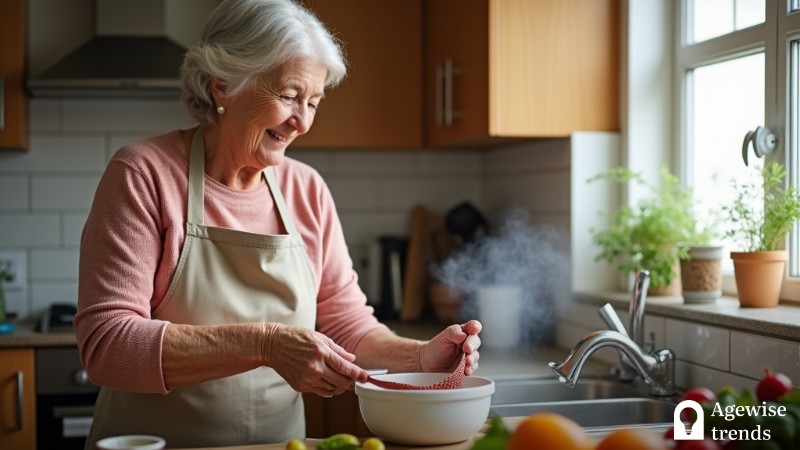The kitchen is the heart of the home, where meals are prepared and time is shared. However, it is also one of the most hazardous areas in the house. Sharp knives, hot surfaces, and boiling water create risks. Even with caution, accidents can happen in seconds.
For older individuals, these dangers become even more serious, especially for those with mobility challenges or cognitive decline.
Recognizing potential hazards and taking proactive measures can help create a safer cooking environment for everyone, particularly those in their later years.
Key Takeaways
The article outlines essential kitchen safety measures for older Americans to minimize risks and boost comfort, focusing on hazards like house fires, falls, and foodborne illnesses.
- Older Americans face a higher risk of kitchen accidents due to mobility challenges and declining cognitive abilities.
- Regular maintenance, the use of adaptive tools, proper storage, and safe lighting are key strategies to reduce kitchen hazards.
- Innovative adaptive tools such as right-angled knives, one-touch can openers, and gripping cutting boards can make cooking safer and more accessible for older adults.
Understanding the risks
Statistics highlight key kitchen safety risks for older adults. The National Fire Protection Association reports that nearly three in ten home fires start in the kitchen, making it the most dangerous room in the house.
The Federal Emergency Management Agency (FEMA) warns that individuals over 65 are 2.7 times more likely to die in a kitchen fire than the general population.
Foodborne illness is another issue, with the Centers for Disease Control and Prevention (CDC) citing 76 million cases annually, including 5,000 fatalities. Weakened immune systems, common among older adults, increase the risk of severe complications from food poisoning.
Kitchens present a significant fall risk due to slippery floors, hard-to-reach items, and the added challenge of carrying meals safely.
Essential kitchen safety tips for seniors
From minimizing hazards to incorporating safety measures, creating a secure kitchen environment for older individuals can help prevent accidents and promote confidence in daily meal preparation.
Here are key strategies to minimize kitchen risks and promote a safer cooking environment for older adults.
Regular maintenance and inspection
Routinely looking for cracks, loose parts, or rust on kitchen appliances and tools can help identify signs of wear early.
Keeping items in good condition reduces the risk of accidents and potential health concerns.
Use of adaptive tools and appliances
Adaptive tools and appliances are designed to make cooking safer and easier for seniors. Products like non-slip mats, ergonomic utensils, and easy-to-use appliances can help reduce the risk of falls and other accidents.
These tools can also make cooking more enjoyable and less physically demanding.
Proper storage and organization
Maintaining an organized and clutter-free kitchen is key to creating a safe cooking environment.
Storing items within easy reach helps reduce the risk of overreaching or straining, which can lead to accidents. Labelling containers and arranging items based on their use times can also minimize unnecessary movement.
Safe lighting and ergonomics
A well-lit kitchen is essential for preventing accidents, particularly in areas where food is prepared and cooking takes place. Adjustable lighting allows for better visibility during different times of the day, reducing potential hazards.
In addition, an ergonomic layout can make cooking more accessible and comfortable, minimizing strain and injury risks.
Being informed and up-to-date
Keeping up with product recalls and safety advisories plays a vital role in maintaining a safe kitchen and protecting the well-being of seniors. By relying on trusted sources, potential hazards can be identified before they become a concern.
In addition, regularly reviewing safety updates allows for timely adjustments that help prevent accidents.
Taking a proactive approach not only minimizes health risks but also fosters confidence in the kitchen, ensuring that seniors can continue to enjoy cooking with greater ease and peace of mind.
Adaptive tools to make cooking safer
Many family caregivers and older individuals may be unaware of the rapid advancements in assistive and adaptive equipment.
Today, a variety of innovative tools and devices are designed to make daily tasks easier, helping seniors maintain independence and safety in the kitchen. Some of the most useful options include the following.
• Right-angled knife: This is specially designed for individuals with disabilities. Its blade extends from the handle at a 90-degree angle, allowing for better cutting control and stability.
• One touch can opener: Offering a hassle-free way to open cans, this device operates with the push of a button, requiring minimal effort from the user.
• Gripping cutting board: Designed for stability and ease of use, this tool helps make meal preparation safer and more efficient. A non-slip surface prevents movement while cutting, while built-in features keep food securely in place.
• Vegetable palm peeler: This compact tool is designed for a secure grip, making peeling easier and more efficient. Its sharp stainless steel blade glides smoothly over vegetables, while the ergonomic shape reduces hand strain for a more comfortable experience.
• Slip resistant adjustable gripping tool: Ideal for older individuals with a weakened grip, limited hand function, or other finger disabilities, this gadget provides a secure hold and assists with opening containers effortlessly.
Conclusion
Ensuring a safe kitchen environment allows older individuals to continue enjoying the cooking experience while maintaining their independence and quality of life.
Thoughtful adjustments, such as proper lighting, adaptive tools, and smart organization, can significantly reduce risks.
By staying vigilant and mindful of potential hazards, the kitchen can remain a space of comfort and enjoyment, promoting both safety and confidence in daily meal preparation.






